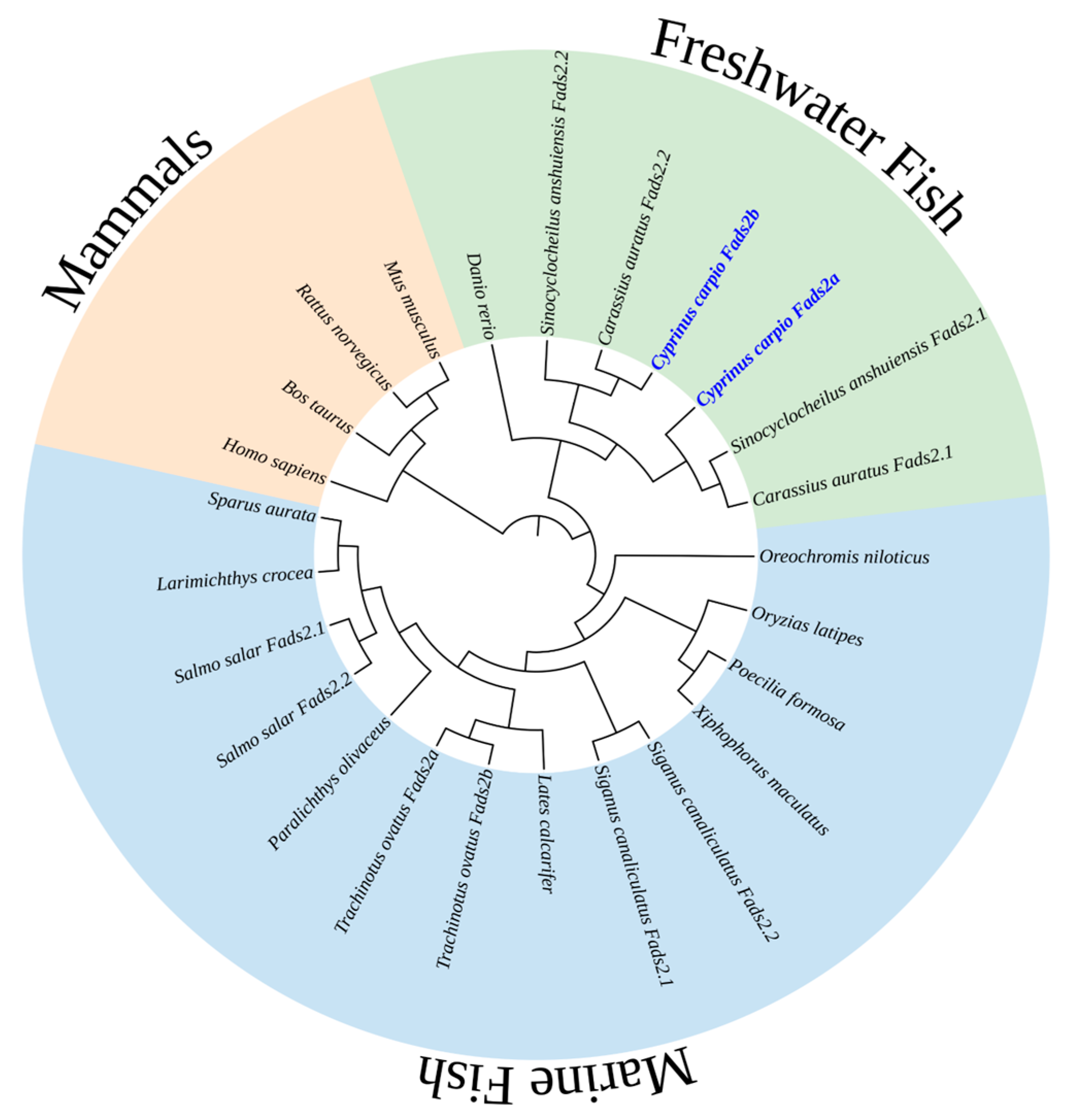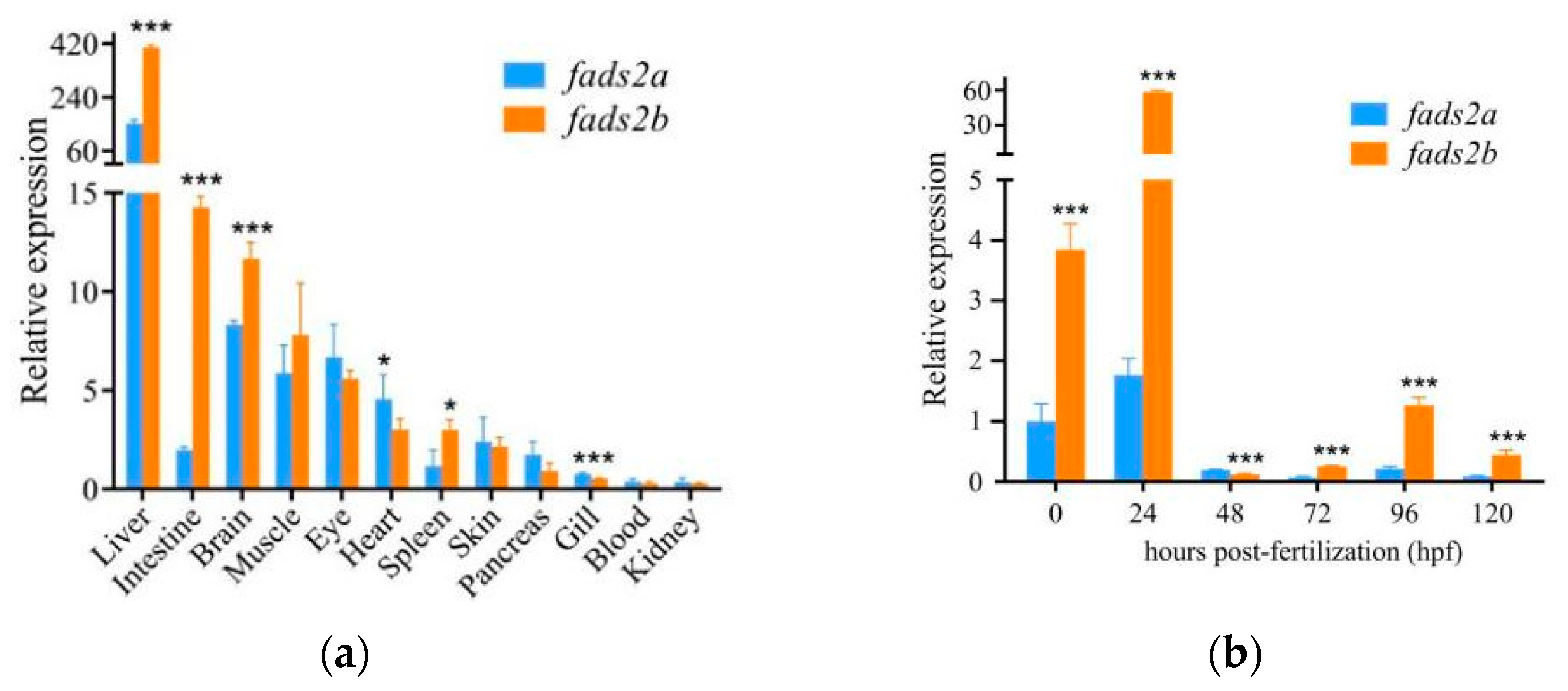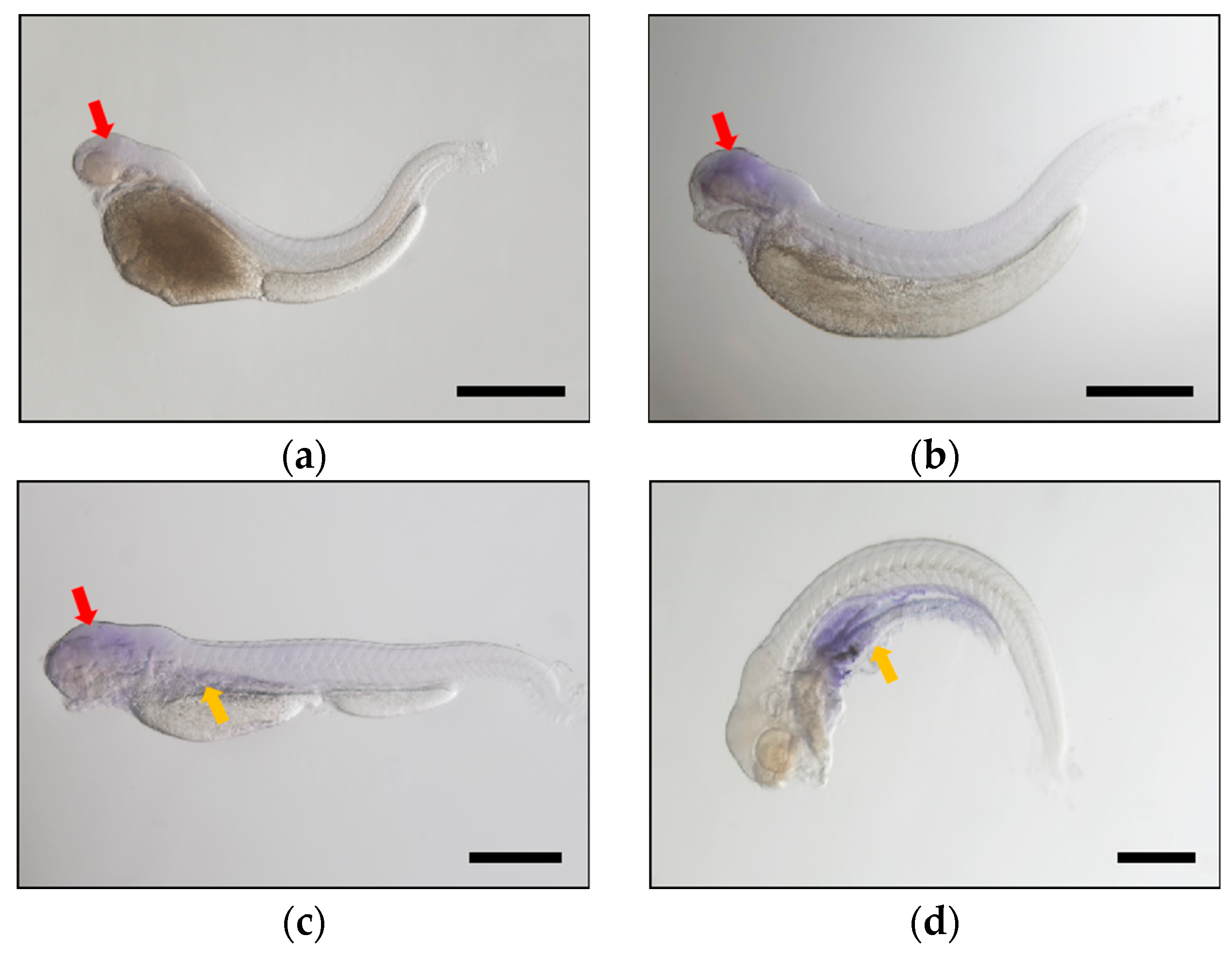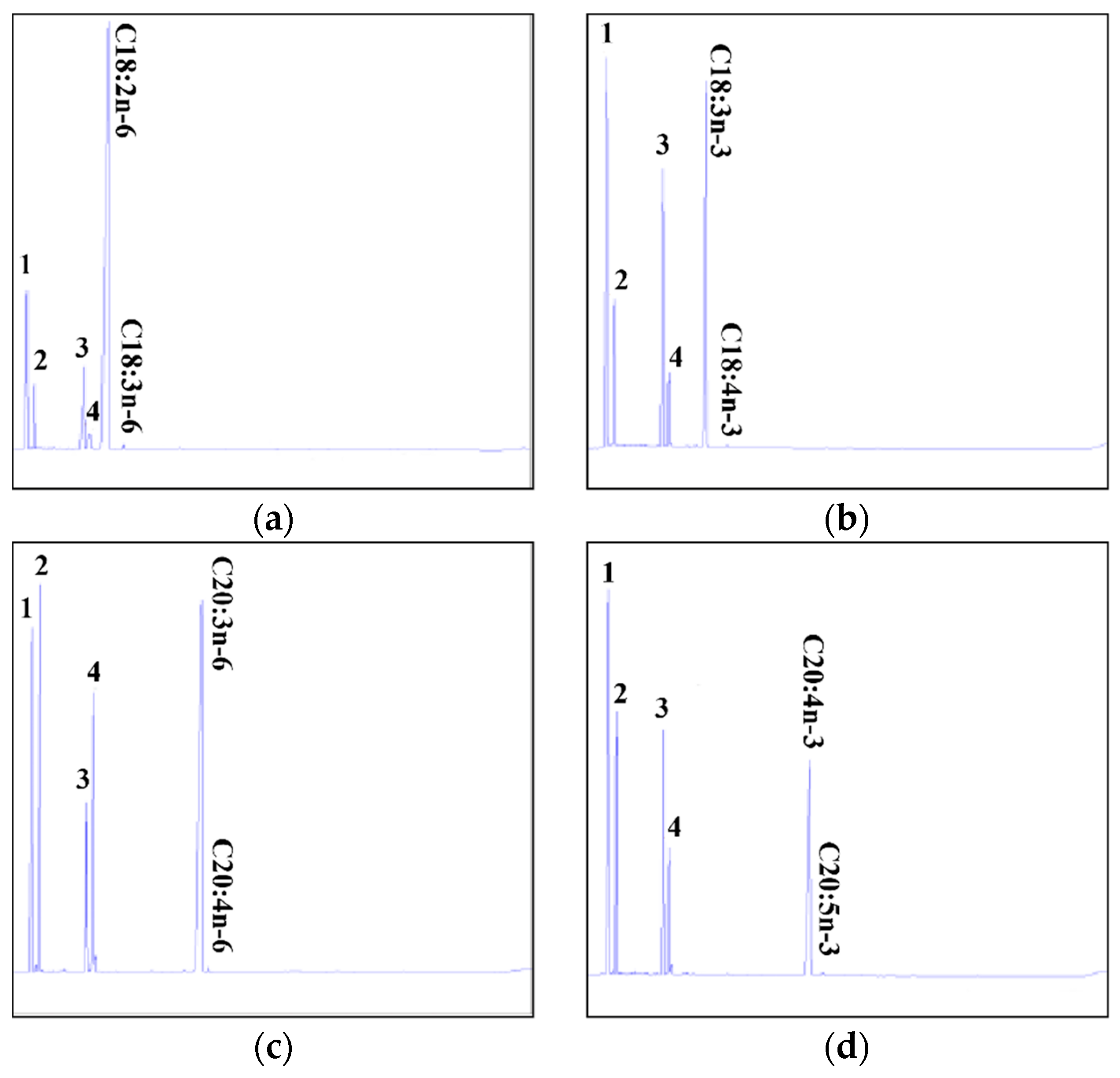Fads2b Plays a Dominant Role in ∆6/∆5 Desaturation Activities Compared with Fads2a in Common Carp (Cyprinus carpio)
Abstract
:1. Introduction
2. Results
2.1. The Differences in Gene and Protein Structures of Common Carp fads2a and fads2b
2.2. Divergent Spatial and Temporal Expression Patterns of fads2a and fads2b In Vivo
2.3. Differences in Desaturation Activities of Common Carp Fads2a and Fads2b in Transgenic Yeast
2.4. Molecular Docking Analyses of Fads2a and Fads2b
2.5. Promoter Activity Analysis of fads2a and fads2b
3. Discussion
4. Materials and Methods
4.1. Animals and Ethics Statement
4.2. Sequence and Structure Analysis of Two Common Carp fads2 Genes
4.3. Phylogenetic Analysis
4.4. GC–MS Analysis of Common Carp Embryos at Different Developmental Stages
4.5. Heterologous Expression of fads2 ORFs in Yeast
4.6. Expression of fads2 Genes during Common Carp Ontogeny
4.7. Whole-Mount In Situ Hybridization (WISH)
4.8. Molecular Docking
4.9. Cloning of fads2a/fads2b Promoters and Construction of Expression Plasmids
4.10. Cell Culture, Transfection and Luciferase Assay
4.11. Statistical Analysis
Supplementary Materials
Author Contributions
Funding
Institutional Review Board Statement
Informed Consent Statement
Data Availability Statement
Acknowledgments
Conflicts of Interest
References
- Lee, J.M.; Lee, H.; Kang, S.; Park, W.J. Fatty Acid Desaturases, Polyunsaturated Fatty Acid Regulation, and Biotechnological Advances. Nutrients 2016, 8, 23. [Google Scholar] [CrossRef] [PubMed] [Green Version]
- Liput, K.P.; Lepczynski, A.; Ogluszka, M.; Nawrocka, A.; Polawska, E.; Grzesiak, A.; Slaska, B.; Pareek, C.S.; Czarnik, U.; Pierzchala, M. Effects of Dietary n-3 and n-6 Polyunsaturated Fatty Acids in Inflammation and Cancerogenesis. Int. J. Mol. Sci. 2021, 22, 6965. [Google Scholar] [CrossRef] [PubMed]
- Gow, R.V.; Hibbeln, J.R. Omega-3 fatty acid and nutrient deficits in adverse neurodevelopment and childhood behaviors. Child Adolesc. Psychiatr. Clin. N. Am. 2014, 23, 555–590. [Google Scholar] [CrossRef] [PubMed] [Green Version]
- Brown, K.M.; Sharma, S.; Baker, E.; Hawkins, W.; van der Merwe, M.; Puppa, M.J. Delta-6-desaturase (FADS2) inhibition and omega-3 fatty acids in skeletal muscle protein turnover. Biochem. Biophys. Rep. 2019, 18, 100622. [Google Scholar] [CrossRef]
- Racine, R.A.; Deckelbaum, R.J. Sources of the very-long-chain unsaturated omega-3 fatty acids: Eicosapentaenoic acid and docosahexaenoic acid. Curr. Opin. Clin. Nutr. Metab. Care 2007, 10, 123–128. [Google Scholar] [CrossRef]
- Ren, H.R.; Yu, J.; Xu, P.; Tang, Y. Single nucleotide polymorphisms of Delta6-desaturase and Elovl5 segments and their associations with common carp (Cyprinus carpio) growth traits. Genet. Mol. Res. 2015, 14, 12848–12854. [Google Scholar] [CrossRef] [PubMed]
- Liao, K.; Ran, Z.; Meng, R.; Xu, J.; Cao, J.; Xu, X.; Wang, Y.; Xu, S.; Yan, X. Long-chain polyunsaturated fatty acid biosynthesis and its response to cadmium exposure in silver pomfret. Aquat. Toxicol. 2019, 206, 61–71. [Google Scholar] [CrossRef] [PubMed]
- Roy, S.; Chakraborty, H.J.; Kumar, V.; Behera, B.K.; Rana, R.S.; Babu, G. In Silico Structural Studies and Molecular Docking Analysis of Delta6-desaturase in HUFA Biosynthetic Pathway. Anim. Biotechnol. 2018, 29, 161–173. [Google Scholar] [CrossRef]
- Geay, F.; Zambonino-Infante, J.; Reinhardt, R.; Kuhl, H.; Santigosa, E.; Cahu, C.; Mazurais, D. Characteristics of fads2 gene expression and putative promoter in European sea bass (Dicentrarchus labrax): Comparison with salmonid species and analysis of CpG methylation. Mar. Genom. 2012, 5, 7–13. [Google Scholar] [CrossRef] [Green Version]
- Zheng, X.; Seiliez, I.; Hastings, N.; Tocher, D.R.; Panserat, S.; Dickson, C.A.; Bergot, P.; Teale, A.J. Characterization and comparison of fatty acyl Delta6 desaturase cDNAs from freshwater and marine teleost fish species. Comp. Biochem. Physiol. B Biochem. Mol. Biol. 2004, 139, 269–279. [Google Scholar] [CrossRef]
- Oboh, A.; Kabeya, N.; Carmona-Antonanzas, G.; Castro, L.F.C.; Dick, J.R.; Tocher, D.R.; Monroig, O. Two alternative pathways for docosahexaenoic acid (DHA, 22:6n-3) biosynthesis are widespread among teleost fish. Sci. Rep. 2017, 7, 3889. [Google Scholar] [CrossRef] [PubMed] [Green Version]
- Zheng, X.; Leaver, M.J.; Tocher, D.R. Long-chain polyunsaturated fatty acid synthesis in fish: Comparative analysis of Atlantic salmon (Salmo salar L.) and Atlantic cod (Gadus morhua L.) Delta6 fatty acyl desaturase gene promoters. Comp. Biochem. Physiol. B Biochem. Mol. Biol. 2009, 154, 255–263. [Google Scholar] [CrossRef] [PubMed]
- Xu, H.; Dong, X.; Ai, Q.; Mai, K.; Xu, W.; Zhang, Y.; Zuo, R. Regulation of tissue LC-PUFA contents, Delta6 fatty acyl desaturase (FADS2) gene expression and the methylation of the putative FADS2 gene promoter by different dietary fatty acid profiles in Japanese seabass (Lateolabrax japonicus). PLoS ONE 2014, 9, e87726. [Google Scholar] [CrossRef]
- Dong, Y.; Zhao, J.; Chen, J.; Wang, S.; Liu, Y.; Zhang, Q.; You, C.; Monroig, O.; Tocher, D.R.; Li, Y. Cloning and characterization of ∆6/∆5 fatty acyl desaturase (Fad) gene promoter in the marine teleost Siganus canaliculatus. Gene 2018, 647, 174–180. [Google Scholar] [CrossRef] [PubMed]
- Abbas, K.A.; Mohamed, A.; Jamilah, B. Fatty acids in fish and beef and their nutritional values: A review. J. Food Agric. Environ. 2009, 7, 37–42. [Google Scholar]
- Ren, H.T.; Zhang, G.Q.; Li, J.L.; Tang, Y.K.; Li, H.X.; Yu, J.H.; Xu, P. Two Delta6-desaturase-like genes in common carp (Cyprinus carpio var. Jian): Structure characterization, mRNA expression, temperature and nutritional regulation. Gene 2013, 525, 11–17. [Google Scholar] [CrossRef]
- Ren, H.T.; Yu, J.H.; Xu, P.; Tang, Y.K. Influence of dietary fatty acids on muscle fatty acid composition and expression levels of Delta6 desaturase-like and Elovl5-like elongase in common carp (Cyprinus carpio var. Jian). Comp. Biochem. Physiol. B Biochem. Mol. Biol. 2012, 163, 184–192. [Google Scholar] [CrossRef]
- Zhang, Y.; Sun, X.Q.; Ye, Y.Q.; Wang, Q.; Li, Q.S.; Zhao, R.; Wang, H.W.; Li, J.T. Association between the Polymorphisms of fads2a and fads2b and Poly-Unsaturated Fatty Acids in Common Carp (Cyprinus carpio). Animals 2021, 11, 1780. [Google Scholar] [CrossRef]
- Li, J.T.; Wang, Q.; Huang Yang, M.D.; Li, Q.S.; Cui, M.S.; Dong, Z.J.; Wang, H.W.; Yu, J.H.; Zhao, Y.J.; Yang, C.R.; et al. Parallel subgenome structure and divergent expression evolution of allo-tetraploid common carp and goldfish. Nat. Genet. 2021, 53, 1493–1503. [Google Scholar] [CrossRef]
- Mraz, J.; Pickova, J. Factors influencing fatty acid composition of common carp (Cyprinus carpio) muscle. Neuro Endocrinol. Lett. 2011, 32 (Suppl. S2), 3–8. [Google Scholar] [PubMed]
- Burducea, M.; Dincheva, I.; Dirvariu, L.; Oprea, E.; Zheljazkov, V.D.; Barbacariu, C.A. Wheat and Barley Grass Juice Addition to a Plant-Based Feed Improved Growth and Flesh Quality of Common Carp (Cyprinus carpio). Animals 2022, 12, 1046. [Google Scholar] [CrossRef] [PubMed]
- Longo, S.B.; Clark, B.; York, R.; Jorgenson, A.K. Aquaculture and the displacement of fisheries captures. Conserv. Biol. 2019, 33, 832–841. [Google Scholar] [CrossRef] [PubMed]
- Zhong, Z.; Niu, P.; Wang, M.; Huang, G.; Xu, S.; Sun, Y.; Xu, X.; Hou, Y.; Sun, X.; Yan, Y.; et al. Targeted disruption of sp7 and myostatin with CRISPR-Cas9 results in severe bone defects and more muscular cells in common carp. Sci. Rep. 2016, 6, 22953. [Google Scholar] [CrossRef] [Green Version]
- Xu, P.; Xu, J.; Liu, G.; Chen, L.; Zhou, Z.; Peng, W.; Jiang, Y.; Zhao, Z.; Jia, Z.; Sun, Y.; et al. The allotetraploid origin and asymmetrical genome evolution of the common carp Cyprinus carpio. Nat. Commun. 2019, 10, 4625. [Google Scholar] [CrossRef] [Green Version]
- Guillou, H.; Zadravec, D.; Martin, P.G.; Jacobsson, A. The key roles of elongases and desaturases in mammalian fatty acid metabolism: Insights from transgenic mice. Prog. Lipid Res. 2010, 49, 186–199. [Google Scholar] [CrossRef] [PubMed]
- Castro, L.F.; Monroig, O.; Leaver, M.J.; Wilson, J.; Cunha, I.; Tocher, D.R. Functional desaturase Fads1 (Delta5) and Fads2 (Delta6) orthologues evolved before the origin of jawed vertebrates. PLoS ONE 2012, 7, e31950. [Google Scholar] [CrossRef] [Green Version]
- Lopes-Marques, M.; Kabeya, N.; Qian, Y.; Ruivo, R.; Santos, M.M.; Venkatesh, B.; Tocher, D.R.; Castro, L.F.C.; Monroig, O. Retention of fatty acyl desaturase 1 (fads1) in Elopomorpha and Cyclostomata provides novel insights into the evolution of long-chain polyunsaturated fatty acid biosynthesis in vertebrates. BMC Evol. Biol. 2018, 18, 157. [Google Scholar] [CrossRef] [Green Version]
- Li, Y.; Monroig, O.; Zhang, L.; Wang, S.; Zheng, X.; Dick, J.R.; You, C.; Tocher, D.R. Vertebrate fatty acyl desaturase with Delta4 activity. Proc. Natl. Acad. Sci. USA 2010, 107, 16840–16845. [Google Scholar] [CrossRef] [Green Version]
- Zhu, K.C.; Song, L.; Guo, H.Y.; Guo, L.; Zhang, N.; Liu, B.S.; Jiang, S.G.; Zhang, D.C. Identification of Fatty Acid Desaturase 6 in Golden Pompano Trachinotus ovatus (Linnaeus 1758) and Its Regulation by the PPARalphab Transcription Factor. Int. J. Mol. Sci. 2018, 20, 23. [Google Scholar] [CrossRef] [Green Version]
- Arnemo, M.; Kavaliauskis, A.; Andresen, A.M.S.; Bou, M.; Berge, G.M.; Ruyter, B.; Gjoen, T. Effects of dietary n-3 fatty acids on Toll-like receptor activation in primary leucocytes from Atlantic salmon (Salmo salar). Fish Physiol. Biochem. 2017, 43, 1065–1080. [Google Scholar] [CrossRef]
- Zheng, X.; Tocher, D.R.; Dickson, C.A.; Bell, J.G.; Teale, A.J. Highly unsaturated fatty acid synthesis in vertebrates: New insights with the cloning and characterization of a delta6 desaturase of Atlantic salmon. Lipids 2005, 40, 13–24. [Google Scholar] [CrossRef] [PubMed]
- Tocher, D.R.; Zheng, X.; Schlechtriem, C.; Hastings, N.; Dick, J.R.; Teale, A.J. Highly unsaturated fatty acid synthesis in marine fish: Cloning, functional characterization, and nutritional regulation of fatty acyl delta 6 desaturase of Atlantic cod (Gadus morhua L.). Lipids 2006, 41, 1003–1016. [Google Scholar] [CrossRef] [PubMed]
- Tang, C.; Cho, H.P.; Nakamura, M.T.; Clarke, S.D. Regulation of human delta-6 desaturase gene transcription: Identification of a functional direct repeat-1 element. J. Lipid Res. 2003, 44, 686–695. [Google Scholar] [CrossRef] [PubMed] [Green Version]
- Yang, J.; Yan, R.; Roy, A.; Xu, D.; Poisson, J.; Zhang, Y. The I-TASSER Suite: Protein structure and function prediction. Nat. Methods 2015, 12, 7–8. [Google Scholar] [CrossRef] [Green Version]
- Uppuladinne, M.V.N.; Dowerah, D.; Sonavane, U.B.; Ray, S.K.; Deka, R.C.; Joshi, R.R. Structural insight into locked nucleic acid based novel antisense modifications: A DFT calculations at monomer and MD simulations at oligomer level. J. Mol. Graph. Model. 2021, 107, 107945. [Google Scholar] [CrossRef]
- Kumar, S.; Stecher, G.; Tamura, K. MEGA7: Molecular Evolutionary Genetics Analysis Version 7.0 for Bigger Datasets. Mol. Biol. Evol. 2016, 33, 1870–1874. [Google Scholar] [CrossRef] [Green Version]
- Saitou, N.; Nei, M. The neighbor-joining method: A new method for reconstructing phylogenetic trees. Mol. Biol. Evol. 1987, 4, 406–425. [Google Scholar] [CrossRef]
- Felsenstein, J. Confidence Limits on Phylogenies: An Approach Using the Bootstrap. Evolution 1985, 39, 783–791. [Google Scholar] [CrossRef]
- Ciccarelli, F.D.; Doerks, T.; von Mering, C.; Creevey, C.J.; Snel, B.; Bork, P. Toward automatic reconstruction of a highly resolved tree of life. Science 2006, 311, 1283–1287. [Google Scholar] [CrossRef] [Green Version]
- Zhao, R.; Wang, Y.X.; Yang, C.R.; Li, S.Q.; Li, J.C.; Sun, X.Q.; Wang, H.W.; Wang, Q.; Zhang, Y.; Li, J.T. Dominant Elongase Activity of Elovl5a but Higher Expression of Elovl5b in Common Carp (Cyprinus carpio). Int. J. Mol. Sci. 2022, 23, 14666. [Google Scholar] [CrossRef]
- Bell, M.V.; Dick, J.R.; Porter, A.E. Tissue deposition of n-3 FA pathway intermediates in the synthesis of DHA in rainbow trout (Oncorhynchus mykiss). Lipids 2003, 38, 925–931. [Google Scholar] [CrossRef] [PubMed]
- Zhou, X.; Zheng, W.; Li, Y.; Pearce, R.; Zhang, C.; Bell, E.W.; Zhang, G.; Zhang, Y. I-TASSER-MTD: A deep-learning-based platform for multi-domain protein structure and function prediction. Nat. Protoc. 2022, 17, 2326–2353. [Google Scholar] [CrossRef] [PubMed]
- Case, D.A.; Cheatham, T.E., 3rd; Darden, T.; Gohlke, H.; Luo, R.; Merz, K.M., Jr.; Onufriev, A.; Simmerling, C.; Wang, B.; Woods, R.J. The Amber biomolecular simulation programs. J. Comput. Chem. 2005, 26, 1668–1688. [Google Scholar] [CrossRef] [PubMed] [Green Version]








| FA Substrate | Product | FA Substrate Peak Area (pA·s) | Product Peak Area (pA·s) | Conversion (%) | |
|---|---|---|---|---|---|
| Fads2a | C18:2n-6 | C18:3n-6 | 30,945.8 | 101.4 | 0.33 |
| Fads2a | C18:3n-3 | C18:4n-3 | 325.5 | 4.8 | 1.45 |
| Fads2a | C20:3n-6 | C20:4n-6 | 3817.5 | 10.9 | 0.28 |
| Fads2a | C20:4n-3 | C20:5n-3 | 2194.9 | 17.2 | 0.78 |
| Fads2b | C18:2n-6 | C18:3n-6 | 8603.6 | 51.4 | 0.59 |
| Fads2b | C18:3n-3 | C18:4n-3 | 7850.4 | 318.2 | 3.89 |
| Fads2b | C20:3n-6 | C20:4n-6 | 2762.5 | 8.9 | 0.32 |
| Fads2b | C20:4n-3 | C20:5n-3 | 3870 | 42 | 1.07 |
| Fatty Acids | Docking Energy (kcal/mol) | |
|---|---|---|
| Fads2a | Fads2b | |
| C18:2n-6 | −5.86 | −5.04 |
| C18:3n-3 | −5.83 | −6.13 |
| C20:3n-6 | −5.98 | −5.54 |
| C20:4n-3 | −5.73 | −5.84 |
Disclaimer/Publisher’s Note: The statements, opinions and data contained in all publications are solely those of the individual author(s) and contributor(s) and not of MDPI and/or the editor(s). MDPI and/or the editor(s) disclaim responsibility for any injury to people or property resulting from any ideas, methods, instructions or products referred to in the content. |
© 2023 by the authors. Licensee MDPI, Basel, Switzerland. This article is an open access article distributed under the terms and conditions of the Creative Commons Attribution (CC BY) license (https://creativecommons.org/licenses/by/4.0/).
Share and Cite
Zhao, R.; Yang, C.-R.; Wang, Y.-X.; Xu, Z.-M.; Li, S.-Q.; Li, J.-C.; Sun, X.-Q.; Wang, H.-W.; Wang, Q.; Zhang, Y.; et al. Fads2b Plays a Dominant Role in ∆6/∆5 Desaturation Activities Compared with Fads2a in Common Carp (Cyprinus carpio). Int. J. Mol. Sci. 2023, 24, 10638. https://doi.org/10.3390/ijms241310638
Zhao R, Yang C-R, Wang Y-X, Xu Z-M, Li S-Q, Li J-C, Sun X-Q, Wang H-W, Wang Q, Zhang Y, et al. Fads2b Plays a Dominant Role in ∆6/∆5 Desaturation Activities Compared with Fads2a in Common Carp (Cyprinus carpio). International Journal of Molecular Sciences. 2023; 24(13):10638. https://doi.org/10.3390/ijms241310638
Chicago/Turabian StyleZhao, Ran, Chen-Ru Yang, Ya-Xin Wang, Zi-Ming Xu, Shang-Qi Li, Jin-Cheng Li, Xiao-Qing Sun, Hong-Wei Wang, Qi Wang, Yan Zhang, and et al. 2023. "Fads2b Plays a Dominant Role in ∆6/∆5 Desaturation Activities Compared with Fads2a in Common Carp (Cyprinus carpio)" International Journal of Molecular Sciences 24, no. 13: 10638. https://doi.org/10.3390/ijms241310638





